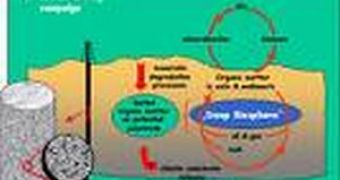It's like in "Journey to the Center of the Earth" by Jules Vernes.
Earth does not cease to reserve us surprises, in an era when we plan colonies on the Moon....
Analyzing the results of an Ocean Drilling Program on the board of the research ship "Joides Resolution", scientists estimated that 10 to 50 % of all the biomass on the Earth is found deep below ground.
The researchers found living microorganisms in drilled cores from up to 400 meters below the sea floor; contamination was ruled out.
In the upper layers of sediment, up to 100 million microorganisms/ml were counted; deeper, in the 35 million year old sediments on the Earth's crust, there were still 1 million microorganisms/ml.
Only the upper layers are in contact with the ocean water, so scientists were puzzled by where the energy to provide life in the depths of the sediment came from.
Taking as a basis the energy sources in the deposits that are available to the cells in the form of organic carbon compounds, it is possible to calculate that the cells could only divide every thousand years, which is not plausible with current understanding of living cells.
To solve the puzzle, the American-German team used the latest technologies from biogeochemistry, molecular biology and microbiology in analyzing a wide range of samples from the bottom of the sea.
They found a model which explains microorganisms' survival due to the natural radioactivity deep under the sea floor. This provides energy that breaks water apart in hydrogen and oxygen.
Radioactivity is produced by the decomposition of naturally occurring potassium, thorium and uranium isotopes.
This process can deliver sufficient energy for the microorganisms, making these communities independent from the Earth's surface.
This phenomenon could have happened on other planets, too. In December 2006, the team will take samples from South Pacific at the board of the drilling ship "RV Roger Revelle".
Far away from the continental shelves, the quantity of organic compounds on the surface communities is very low, so the scientists want to see how this influences the Deep Biosphere communities.

 14 DAY TRIAL //
14 DAY TRIAL //